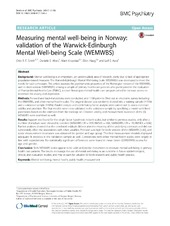| dc.contributor.author | Smith, Otto Robert Frans | |
| dc.contributor.author | Alves, Daniele Evelin | |
| dc.contributor.author | Knapstad, Marit | |
| dc.contributor.author | Haug, Ellen | |
| dc.contributor.author | Aarø, Leif Edvard | |
| dc.date.accessioned | 2017-09-20T11:33:55Z | |
| dc.date.available | 2017-09-20T11:33:55Z | |
| dc.date.issued | 2017-05-12 | |
| dc.Published | Smith ORF, Alves DE, Knapstad M, Haug E, Aarø LE. Measuring mental well-being in Norway: validation of the Warwick-Edinburgh Mental Well-being Scale (WEMWBS). BMC Psychiatry. 2017;17:182 | eng |
| dc.identifier.issn | 1471-244X | |
| dc.identifier.uri | https://hdl.handle.net/1956/16681 | |
| dc.description.abstract | Background: Mental well-being is an important, yet understudied, area of research, partly due to lack of appropriate population-based measures. The Warwick-Edinburgh Mental Well-being Scale (WEMWBS) was developed to meet the needs for such a measure. This article assesses the psychometric properties of the Norwegian version of the WEMWBS, and its short-version (SWEMWBS) among a sample of primary health care patients who participated in the evaluation of Prompt Mental Health Care (PMHC), a novel Norwegian mental health care program aimed to increase access to treatment for anxiety and depression. Methods: Forward and back-translations were conducted, and 1168 patients filled out an electronic survey including the WEMWBS, and other mental health scales. The original dataset was randomly divided into a training sample (≈70%) and a validation sample (≈30%). Parallel analysis and confirmatory factor analysis were carried out to assess construct validity and precision. The final models were cross-validated in the validation sample by specifying a model with fixed parameters based on the estimates from the trainings set. Criterion validity and measurement invariance of the (S) WEMWBS were examined as well. Results: Support was found for the single factor hypothesis in both scales, but similar to previous studies, only after a number of residuals were allowed to correlate (WEMWBS: CFI = 0.99; RMSEA = 0.06, SWEMWBS: CFI = .99; RMSEA = 0.06). Further analyses showed that the correlated residuals did not alter the meaning of the underlying construct and did not substantially affect the associations with other variables. Precision was high for both versions of the WEMWBS (>.80), and scalar measurement invariance was obtained for gender and age group. The final measurement models displayed adequate fit statistics in the validation sample as well. Correlations with other mental health scales were largely in line with expectations. No statistically significant differences were found in mean latent (S)WEMWBS scores for age and gender. Conclusion: Both WEMWBS scales appear to be valid and precise instruments to measure mental well-being in primary health care patients. The results encourage the use of mental well-being as an outcome in future epidemiological, clinical, and evaluation studies, and may as such be valuable for both research and public health practice. | en_US |
| dc.language.iso | eng | eng |
| dc.publisher | BioMed Central | eng |
| dc.relation.uri | https://bmcpsychiatry.biomedcentral.com/track/pdf/10.1186/s12888-017-1343-x?site=bmcpsychiatry.biomedcentral.com | |
| dc.rights | Attribution CC BY | eng |
| dc.rights.uri | http://creativecommons.org/licenses/by/4.0 | eng |
| dc.subject | Mental well-being | eng |
| dc.subject | mental health | eng |
| dc.subject | public health | eng |
| dc.subject | measurement | eng |
| dc.title | Measuring mental well-being in Norway: validation of the Warwick-Edinburgh Mental Well-being Scale (WEMWBS) | eng |
| dc.type | Peer reviewed | |
| dc.type | Journal article | |
| dc.date.updated | 2017-09-08T11:46:59Z | |
| dc.description.version | publishedVersion | |
| dc.rights.holder | Copyright 2017 The Author(s) | eng |
| dc.identifier.doi | https://doi.org/10.1186/s12888-017-1343-x | |
| dc.identifier.cristin | 1471321 | |
| dc.source.journal | BMC Psychiatry | |

